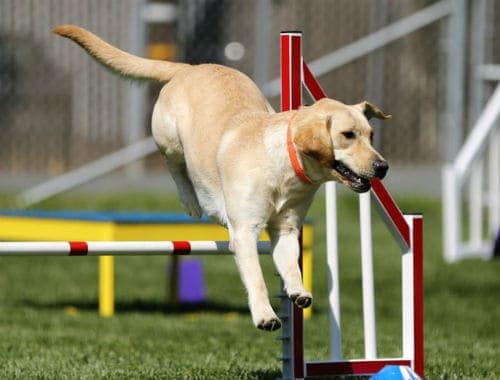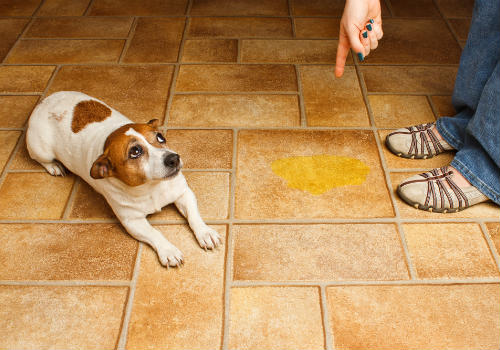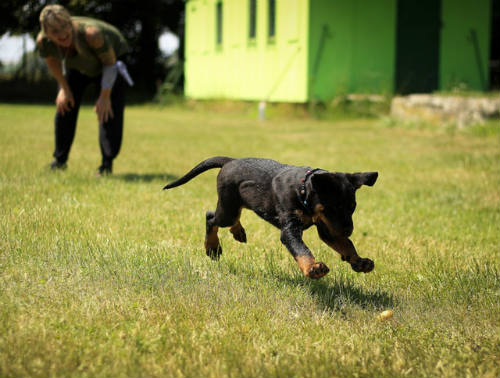Wouldn’t it be nice if your dog was always on his best behavior?
No incessant barking at nothing, no chewing up your new throw pillow or favorite shoes, no bolting out the front door every time you open it… sounds like a dream come true!
But owning a dog is like having a perpetual 2-year-old, and like toddlers, dogs aren’t the greatest at telling right from wrong. They navigate the world through impulse and instinct, which can lead to many unwanted behaviors.
So what should you do when your pup won’t stop acting up? What’s the best way to correct your dog’s behavior without tarnishing the bond and trust you two share?
Here’s the ultimate guide to doggy discipline dos and don’ts. These techniques are tried and trusted by dog trainers, behavioralists, vets and happy owners around the world — let’s see why!
Dog Discipline Don’ts

Let’s get the no-nos out of the way first.
Antiquated advice may recommend these disciplinary tactics, but more recent evidence suggests that they do more harm than good.
Avoid using these methods to discipline your dog — at best, they’re ineffective, and at worst, they could make bad behavior even worse.
Don’t Be Dominant
For many years, the prevailing method of dog training was the dominance method.
The theory behind this method goes that dogs structure their relationships according to a hierarchy, in which one dog is dominant over the others. In order to control your dog’s behavior, therefore, you must assert yourself as the dominant member of his “pack.”
Asserting your dominance involves many different things, such as eating your dinner before feeding your dog his or entering rooms first. Doing so, according to dominance theory, teaches your dog that you’re the leader and you always get your way first.
Dominance also entails reacting to bad behaviors with intimidating or forceful tactics. These include pinning your dog to the ground, grabbing him by the scruff of the neck and shouting.
But a 2009 study from the University of Bristol suggests that dominance theory isn’t just untrue, it’s actively harmful.
The idea that dogs only operate according to their place in a hierarchy disregards the depth and nuance of a dog’s intelligence and feelings. Far more goes into a dog’s behavior than a mere desire for dominance (or desire to obey the dominant pack member) — there’s much more reasoning and emotion behind it.
What dominance does do, the study claims, is make your dog afraid of you. His behavior may improve in some cases, but only out of fear that you’ll yell or force him to the ground again.
And fear makes dogs act unpredictably, which frequently means aggression. Often, dogs who are treated with dominance eventually get sick of it and become violent in an attempt to claim dominance for themselves and end the mistreatment.
Don’t Use Physical Force

In many ways, this ties back to the previous “don’t,” but physical discipline doesn’t need to be part of a larger theory of dominance to be wrong.
Hitting, pushing, shaking, slapping, forceful grabbing, dragging and other acts of physical discipline simply don’t work. Dogs can’t connect these actions with their causes anywhere near as well as we think they can, so the result is generalized fear.
If you hit your dog because he won’t stop barking, he won’t make the connection between the barking and the hitting. All he’ll know is that you hit him and it hurt — he’ll only make the connection between you and pain.
This also extends to things like rubbing your dog’s nose in his pee if he has an accident inside. It teaches your dog that you’ll rub his nose in pee, but it does nothing to address the behavior itself.
Those who claim that physical discipline improves behavior are only seeing fear: dogs that are so afraid of getting hit that they’re unable to do anything except sit there and be quiet.
In other words, dogs who are physically disciplined simply end up afraid to be dogs. And a life of fear is not a healthy or happy one — it’s tragic and should be avoided at all costs.
Dog Discipline Dos
Now that the negatives are covered, let’s find out what you should do when your dog misbehaves.
These methods encourage your dog to listen to you rather than fear you. They provide a way to strengthen your bond while still correcting unwanted behaviors — a win-win all around.
Do Practice Positive Reinforcement
The “Don’ts” section covered negative reinforcement: the act of punishing bad behavior. Positive reinforcement, though, involves rewarding good behaviors, with the expectation that your dog will repeat those good behaviors to receive more positive rewards.
And it works: positive reinforcement is used to train service dogs, police dogs, and many other types of working dogs for whom good behavior is a necessity.
If you’re walking your dog and he’s pulling hard on his leash, your gut reaction may be to yank him back, scruff him or scold him. But as we’ve seen, these tactics don’t actually tell the dog what he did wrong.
On the other hand, giving him a
Do Redirect Bad Behavior — and Fast
Disciplining your dog after he’s already misbehaved is woefully ineffective. Your best chance of getting your dog to understand what he did wrong is to catch him in the act and redirect him towards a similar, more healthy behavior.
Redirecting behavior involves working out why your dog is misbehaving, then providing him with a better way to resolve that urge or meet that need.
Let’s say you walk into a room and you find your dog gnawing on a pillow. Obviously, this is no good, but he’s doing it for a reason: maybe he’s teething, bored or just exercising his innate need to chew.
To redirect his pillow-chewing, you’ll want to interrupt him by taking the pillow away and telling him “no” firmly but without yelling.
Then ignore him until he calms down a bit — no pets, no talking, nothing. It’s hard, but he needs to learn that when he chews the pillow, nothing positive comes from it.
After a few minutes of this time-out, replace the pillow with a chew toy, bone, stick or other suitable object.
While he’s chewing on his owner-approved object, pet him and praise him in a friendly voice. This goes back to positive reinforcement — you redirected him to a good behavior and now you need to reinforce it so he repeats it himself next time.
What this teaches your dog is that when he’s feeling like chewing something, the object you gave him is what he should turn to. The key is stopping the bad behavior while it’s occurring.
Do Be Consistent

Inconsistent discipline is probably the number-one reason why positive reinforcement and redirection fail.
Your dog needs a consistent pattern of rewards for them to be effective. Otherwise, he won’t be able to make the connection between them and his behavior.
This means being diligent about observing your dog and reacting to his behavior.
If you only reward him sometimes when he doesn’t tug on his leash, he’ll just assume he’s getting random treats, because he doesn’t always get them for walking calmly.
And if you occasionally let him beg for food because it’s cute, he won’t learn that it’s not okay to do that. He’ll just learn that sometimes you don’t like it, and he’ll keep trying his luck.
You’ll also need to get the entire family on board with the discipline regimen, and get them to follow it consistently. Go over your dog’s most common bad behaviors with the family and show them how to redirect them.
Dogs love routine, so in order to modify their behavior, you need to modify their routine. By making healthy discipline consistent enough to become part of their routine, you’ll instill the trust and security they need to happily and smoothly adjust their behavior.
